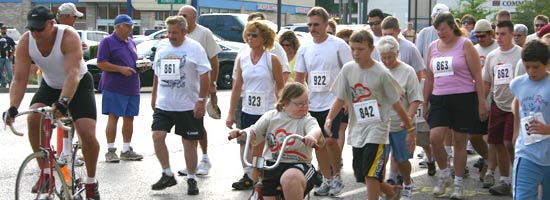Though the first Laurel Run was held in 1997, the event actually had its beginnings in 1963 when Elaine Hotelling gave birth to her and husband Wayne’s first child, a daughter they named Laurel. Not long after she was born, Wayne and Elaine were stunned to learn their little girl had Down syndrome. After the diagnosis, Laurel’s doctor suggested the Hotellings send their daughter to live in an institution. The Hotellings acted quickly.
They changed doctors.
Instead of giving up Laurel, Wayne and Elaine kept their daughter at home, where she grew up in a loving household with three siblings. The Hotelling family did everything they could to integrate Laurel into the community, and to the rest of the people in the neighborhood, Laurel Hotelling was simply Laurel – just another resident of the cozy village of Silver Creek, NY.
A quote from one of Laurel’s childhood friends describes the Hotellings’ outlook:
“I was fortunate to grow up next door to the Hotellings, and I spent many a childhood day in their home. It was there that I saw, first hand, how inclusion and integration can virtually eliminate the lines between the disabled and non-disabled. I can honestly say, there was not one time, in all of the years that I lived next door, that I noticed that Laurel was “different,” and this is clearly a reflection of the way that she was raised. Laurel participated in all of the same activities that the rest of us, as kids, participated in – she belonged to the Brownie Troop, she took dancing and piano lessons, played the same games; Laurel’s “handicap,” as her sister described it, did not prevent her from experiencing the same childhood pleasures that we all have a tendency to take for granted. It was Laurel’s upbringing that allowed her to grow into the secure, happy, and beautiful young lady that she is today.”
It is interesting to note that the woman who wrote these words worked for The Resource Center, and several other Silver Creek natives who grew up with Laurel have also entered the human service field. They all credit the Hotellings with being the inspiration for their chosen professions.
The seeds of Laurel Run were sewn in 1980. That summer, the Hotelling family was on vacation in Canada when they drove past a young man jogging along the side of the road. What caught the Hotellings’ attention was that the man had a prosthetic leg. The Hotellings drove on, and a short while later they came upon a van driven by the jogger’s one-person support team. They learned that the man was a Canadian named Terry Fox, and that he had lost a leg to cancer several years earlier. Terry had decided to try to run across Canada to raise $22 million – a dollar for every Canadian citizen – for cancer research. He called his effort the Marathon of Hope, and for 143 straight days, Terry ran a marathon (26 miles) a day. He made it two-thirds of the way across Canada before it was discovered that the cancer that had claimed his leg had spread to his lungs, leaving him unable to continue running. He died 10 months later, but the Marathon of Hope continued and has spread worldwide, raising more than $550 million.
Wayne was so inspired by Terry Fox that he resolved to someday do something similar to raise awareness about people with disabilities. After retiring from Silver Creek Central School as a teacher and coach in 1995, Wayne began getting in shape for what he would call Laurel Run. In August 1997, with a contingent of well-wishers alongside him, Wayne set off from the New York-Pennsylvania line near Lake Erie in a quest to jog across New York State to the Massachusetts border, a distance of some 420 miles. However, after running 20 miles a day for the first five days, Wayne sustained a leg injury and had to interrupt his journey.
Undaunted, Wayne rested long enough for his leg to heal sufficiently for him to ride a bicycle. He then resumed Laurel Run from the point where he had previously stopped, riding his bicycle most of the way and having Elaine, who accompanied Wayne in the couple’s van, walk up the steeper hills so they could be sure they covered the entire route. The Hotellings finished on time in Columbia County to the cheers of family and friends.
Laurel Run was intended to be a one-time effort. But just as Terry Fox’s Marathon of Hope continued after his death, Laurel Run took on a life of its own. People the Hotellings encountered during their trek across New York State were inspired by their effort, and NYSARC decided to make Laurel Run the keynote event of its 50th anniversary celebration in 1999. That year, Laurel Run passed through every county in New York State, with some 20,000 people taking part.
Since 2001, the Laurel Memorial Run/Walk has been a two-day event in Chautauqua County. Day 1 consists of a relay run from Jamestown to Dunkirk, while on Day 2 the action shifts to the Hotellings’ hometown of Silver Creek for the main events. What has remained a constant feature of the Laurel Memorial Run/Walk, and which continues to grow each year, is the support demonstrated by local businesses and individuals for the Hotellings and the charitable cause they created.
Another heartwarming facet of Laurel Run is the sense of ownership exhibited by Laurel and the hundreds of people with disabilities who participate in the event each year. The Laurel Memorial Run/Walk is THEIR event, and they are extremely proud of that fact.
The Hotellings have received several accolades for their efforts with Laurel Memorial Run and Walk. Wayne, Elaine and Laurel received the Citizen Advocacy Award from NYSRA (the New York State Rehabilitation Association) in 2001, and the family has received numerous local honors. Wayne also has received The Resource Center’s Lifetime Achievement Award.


